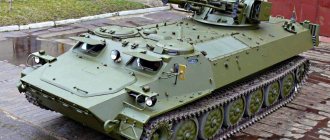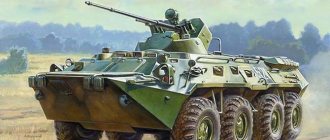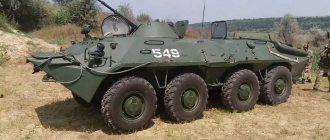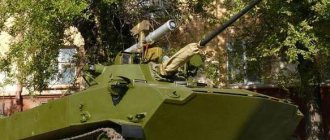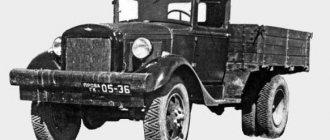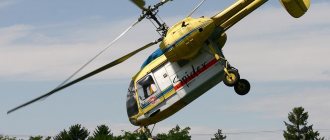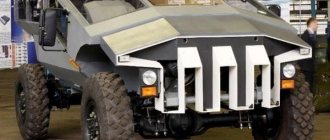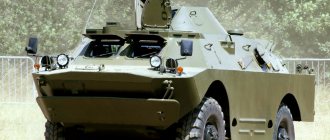The GAZ-71 tracked transporter is a truly unique and universal design. The vehicle can be used to transport cargo, personnel or tow trailers in off-road conditions. The sealed conveyor body allows you to cross water obstacles without any preparation of the machine.
The car was widely used in the northern regions, where it received a lot of nicknames - “Brute Dumb Force”, “Gasushka” or “Zhuzhik”. The GAZ-71 design had great potential for development and modernization. Currently, GAZ-3403 transporters are being produced, slightly different from their predecessor.
History of the creation of the all-terrain vehicle
The development of the GAZ-71 transporter began in the 60s. The vehicle was created on the basis of the GAZ-47 snow and swamp-going vehicle produced since 1955.
The characteristics of serial products began to lag behind the requirements of the main customer - the Soviet Army. It was planned to equip the new tracked all-terrain vehicle with a power unit and transmission unified with the components of the GAZ-66 wheeled army all-terrain vehicle.
The first prototype of the new tracked transporter was assembled in 1965.
A design feature of the experimental vehicles were plastic road wheels. However, the low strength of parts led to the abandonment of the use of plastic in serial products.
The new all-terrain vehicle used expanded caterpillar links, which, together with an increase in the length of the supporting surface, made it possible to reduce the pressure on the ground to 0.071 kgf/cm².
Serial production started in 1968 under the designation GT-SM. In the first years, the production of vehicles was carried out in Gorky, but due to the workload of the plant, production was moved to Zavolzhsk to a specialized plant for tracked tractors. The assembly of the conveyor in Zavolzhsk continued until 1985.
Price
Some GAZ 34039 models have long been discontinued, so they can only be purchased on the secondary market. New series of all-terrain vehicles are sold both directly on the manufacturer’s website and on other automotive sites. On average, the cost of a new GAZ 34039 33 will cost 3 million rubles, and the price of the Irbis model is 3.5 million. A used GAZ 34039 can be found for about one and a half million, and, of course, do not forget about trading. The final cost of the car will depend on its condition, mileage and additional equipment.
In conclusion, it must be said that Russia is a very large country with different climatic conditions, and most similar brands of cars quickly fail in cold regions. Thanks to special protective functions and high-quality equipment, the all-terrain vehicle performs many tasks and is widely used in many areas of production.
Frame
At the heart of the GAZ-71 conveyor is a steel body welded from sheets of various thicknesses. The body is sealed, which allows the vehicle to overcome water obstacles without special training.
The body is divided into three sections:
- cabin;
- engine compartment;
- cargo platform.
The engine compartment is separated from the cabin and cargo part of the transporter by steel bulkheads. The bulkheads have removable hatches designed for servicing the power unit. A pump is installed in the engine compartment, designed to pump out liquid that enters when overcoming water barriers.
The GAZ-71 cabin is completely metal, equipped with two seats: for the driver and passenger.
Access to the cabin is through hinged side doors or through two hatches in the roof. The loading platform is made directly in the conveyor body. To facilitate unloading and loading, the upper part of the tailgate is hinged.
On the sides of the platform there are folding semi-soft seats. The platform is covered from above with a tarpaulin awning mounted on arches. To heat the internal volume of the cargo compartment, a separate liquid-type heater is used.
Operating manual for GAZ-71
Crawler conveyor GT-SM
Manual
Table of contents
Introduction 3 Warning 5 Safety regulations and fire safety requirements 7 Technical characteristics of the conveyor 10 Purpose of the conveyor 10 Basic data 10 General characteristics 11 Filling tanks of the conveyor 18 Basic adjustment data 18 Controls and instruments 20 Controls 20 Instrument panel 23 Running in a new conveyor 25 Power plant 27 Engine 27 Engine mounting 28 Cylinder heads, crank mechanism 29 Distribution mechanism 34 Lubrication system 35 Crankcase ventilation 42 Power system 42 Carburetor 47 Carburetor care and adjustment 48 Speed limiter 48 Accelerator 50 Exhaust system 51 Cooling system 52 Starting and stopping engine 59 Starting a warm (warm) engine 59 Starting a cold engine at moderate temperatures 60 Starting a cold engine at low temperatures 61 Starting engine heater 62 Starting procedure using a starting heater 65 Caring for the starting heater 70 Rules for using the starting heater 71 Starting the engine using the starting handle 73 Stopping the engine 73 List of power unit faults 74 Transmission 81 Clutch 82 Clutch drive 84 List of clutch and drive faults 86 Gearbox 87 List of gearbox faults 92 Transfer case 93 Driveshaft 96 List of propeller shaft faults 98 Final drive 99 List of final drive faults 102 Onboard clutches 103 List of malfunctions of onboard clutches 106 Brakes List of malfunctions on brakes 107 Control drive for onboard clutches and brakes 107 Couplings and axle shafts 110 Final drives 111 List of malfunctions on final drives 112 Chassis 114 Drive wheels 114 Track chains 114 Track rollers 1 18 Guide wheels and tension mechanism tracks 121 Suspension 123 Shock absorbers 124 List of chassis faults 128 Electrical equipment 129 Battery 129 Generator 130 Voltage regulator 130 Starter 131 Engine ignition system 132 Lighting, light and sound alarm 136 Windshield wiper 141 Flexible speedometer drive shaft 141 Fuses 141 Battery switch 141 Trailer socket 142 Socket to start the engine from an external source of electricity 142 Shielded equipment 142 Care of devices 145 General rules for finding electrical faults. networks 145 List of electrical equipment malfunctions 146 Conveyor housing 149 Conveyor equipment 153 Hydrodynamic casings 153 Drainage means 154 AKM mounting 157 Sanitary equipment 157 Towing devices 160 Device for washing windshields 161 Cab and platform heating 161 Installation of license plates 164 Tools and accessories 165 Jack 166 Lever- plunger syringe 167 Pump for manual transfer of gasoline 169 Driver's life jacket 170 Engine compartment covers 170 Checking and adjusting conveyor units and systems 172 List of measuring instruments 172 Technological maps 173 No. 1. Checking and adjusting the gap between the rocker arm and the valve stem 173 No. 2. Checking and adjusting the carburetor K-126B 175 No. 3. Adjusting the carburetor to the minimum engine speed at idle 179 No. 4. Adjusting the free play of the clutch pedal 181 No. 5. Adjusting the free play of the clutch release 182 No.6. Adjusting the control drive for side clutches and brakes 183 No. 7. Adjusting the bearings of the final drive driven shaft 186 No. 8. Adjusting the locking mechanism of the gearbox 187 No.9. Adjusting the tension of track chains 187 No. 10. Adjusting the installation of balancers 188 No. 11. Adjusting the installation of shock absorbers 190 No. 12. Replacing the working fluid in the shock absorber 191 No. 13. Checking and adjusting the gap between the breaker contacts 192 No. 14. Setting the ignition timing 193 No. 15. Adjustment gap between spark plug electrodes 197 No. 16. Headlight adjustment. 198 No. 17.Adjusting the needle of the solenoid valve of the starting heater boiler 199 No.18.Adjusting the tension of the gearbox drive belts 200 No.19.Adjusting the tension of the front fan drive belts 201 No.20.Adjusting the tension of the generator and water pump drive belts 201 Rules for driving a conveyor 203 Pulling off 203 Driving and turning 203 Stopping the conveyor 206 Overcoming obstacles 206 Navigating wetlands and swamps 207 Overcoming water obstacles 208 Driving on sandy terrain 210 Driving on mountain roads 211 Driving in wooded areas 212 Driving the conveyor with a trailer 212 Towing the conveyor 213 Pulling out the conveyor 21 4 Winter operation of the conveyor 216 Features of winter operation 216 Driving in deep snow 217 Driving on slippery and icy roads 218 Driving on ice 219 Maintenance of the conveyor 220 Inspection before leaving 220 Inspection at small rest stops 221 Daily maintenance 222 Preservation of the conveyor 228 Lubrication of conveyor mechanisms 229 Lubrication chart 2 32
You can download the GAZ-71 operating instructions here
Engine
The GAZ-71 conveyor is equipped with a gasoline power unit with a carburetor fuel supply system. The engine has eight cylinders with a displacement of 4250 cm³ (4.25 l). Structurally, the engine is a modification of the power unit from GAZ-66 trucks. The engine develops a power of 115 hp.
Gasoline A-76 or AI-93 is used as fuel.
The plant allowed the engine to run on A-72 gasoline when installing an octane corrector for later ignition.
A special feature of the engine design is the installation of a standard P-16 heater running on gasoline. The heater warms up the coolant and oil in the crankcase for starting at low ambient temperatures.
Transmission
The GAZ-71 conveyor is equipped with a mechanical four-speed gearbox and a dry clutch. The clutch design uses one disc with a diameter of 300 mm. The box is equipped with synchronizers in the two highest gears (fourth speed – direct). Switching the first two speeds is performed with throttle reversal. The operating range of the transmission is expanded by installing a transfer gearbox with overdrive and downshift gears.
The torque from the transfer gearbox is supplied to a single-stage main gear installed in an aluminum crankcase. A cardan shaft is used for transmission. Dry friction side clutches are installed at the output of the main pair.
Each clutch consists of 19 discs, which are controlled by a cam mechanism.
Clutches control single-stage final drives with spur gears. Axle shafts with gear couplings are used to connect clutches and gears.
Caterpillars: Design and purpose
Later, a reinforced rubber-metal propulsion unit with a peripheral frame and two large support wheels was tested on a production GAZ-66 truck with an all-metal cab. The car used an original search transmission designed by engineer Boris Akimovich Dekhtyar with a centrally located transfer case and through-bevel main gears of both middle axles with cam limited-slip differentials, from which torque was redistributed to the outer axles.
Control
To control the GAZ-71 conveyor, a system of levers and pedals is used. The pedal drive has a throttle valve and a clutch. Switching speeds in the gearbox and transfer gearbox is carried out by separate levers. The rotation is performed by disabling the side clutch clutches, the shutdown drive is carried out using levers.
To control various equipment, buttons and toggle switches located on the instrument panel are used.
Devices
An instrument panel is located on the central part of the dashboard of the GAZ-71 conveyor. On the sides of the shield there are deflectors for blowing hot air onto the windshield. The instrument panel consists of a free-standing speedometer and a rectangular console on which additional instruments, switches and indicator lamps are installed.
Closer to the speedometer there is an engine temperature indicator, behind which there is an oil thermometer, pressure gauge, ammeter and fuel level indicator in the tank. Since the GAZ-71 tracked all-terrain vehicle uses four fuel tanks, the dashboard has a level indicator switch between the tanks. To illuminate the devices, lamps installed above the devices are used.
History of the model
The idea of creating a car capable of moving over any terrain, overcoming even the most serious obstacles, appeared in the mid-60s of the last century, when the huge “Country of Soviets”, through titanic efforts, finally managed to recover after the Great Patriotic War.
It was planned that the machine would be used to explore hard-to-reach territories of the Far East, Siberia, etc. It was supposed to serve the development of the gas, oil and petrochemical industries. Looking ahead a little, we note that the GAZ-71 all-terrain vehicle coped with the task perfectly.
Important
It is important to note that the new vehicle, among other things, had to move not only on land, but also on water, and perform its functions in harsh climatic conditions, such as critically low temperatures and high humidity levels.
As mentioned above, the predecessor of the 71st model was the 47, produced at the enterprise we mentioned in the period from 54 to 64. It was used in various spheres of human life and was valued for its reliability and high maneuverability. However, the all-terrain vehicle was morally outdated - it became clear that it urgently needed to be replaced by a more modern model at that time.
The “father” of the car is considered to be the famous designer V. Rogozhin, who, taking the GAZ-47 as a basis, completely reconfigured it, moved the power plant to the middle of the vehicle, turned it in the opposite direction of movement and placed it between the troop compartment and the cabin.
This solution made it possible to install higher power motors and achieve ideal weight distribution. The all-terrain vehicle has become longer and lower, its driving performance has improved, including when driving on water. The model was tested in different conditions - in swamps, in the desert, and even on the Kola Peninsula.
During the production of the GAZ-71, its creators faced a serious problem: it became clear that the production capacity of the enterprise was not enough to meet the needs of a large country. That is why, over time, the production line was moved to the more powerful Zavolzhsky plant, but this only happened in 1973.
Caterpillars
The GAZ-71 conveyor uses a steel small-link caterpillar, composed of 83 links each. The link has a width of 390 mm, the distance between the axes of the finger holes is 128 mm.
On the inner surface of the link there are two feathers that limit the treadmill and prevent the track from coming off the track rollers.
The links are connected to each other using steel fingers, secured against falling out with locking rings. To ensure the durability of the finger, the surface is saturated with boron, followed by hardening with high frequency currents. On the body between the first roller and the drive sprocket there is a removable plate that cleans the track from dirt and snow. The tracks are tensioned by turning the guide roller balancer crank.
Rollers
The GAZ-71 conveyor is equipped with six steel road wheels with a diameter of 700 mm with external rubber shock absorption. The rear rollers serve as idler wheels. The rollers are mounted on steel balancers.
The balancer suspension is torsion bar, supplemented with hydraulic shock absorbers. Telescopic shock absorber cartridges are installed on the balancers of the front rollers and idler wheels. The drive wheels are located at the front. The ring gear is equipped with 12 teeth, the unit is removable and interchangeable.
All-terrain vehicle characteristics
GAZ 71 diesel has technical characteristics that distinguish it favorably from the previous GAZ 47 model. Let's consider the main ones.
The GAZ 71 engine has 8 cylinders. It runs on gasoline. It is a strong carburetor with a capacity of 115 horsepower. Volume – 4.25 l. The engine is part of a single system. It is built into the engine compartment. It also includes a gearbox, a single-plate dry clutch and an additional gear. The gearbox is mechanical, four-speed. It has five speeds - four forward and four reverse. The transfer case has two gears, inherited from the GAZ 66. The device also includes final drives and a double band brake system.
Be sure to read: How to buy MTLB from conservation
The chassis consists of the following components:
- support rollers. There are 12 of them in total;
- tracks covered with rubber. There are 6 of them on each side;
- driving wheels (2 pieces).
Hydraulic shock absorbers are installed on the rear guides and front rollers.
When moving in snowy areas, special removable snow blowers are installed on the tracks. They prevent ice from forming and prevent snow from sticking.
The body is an open steel heated cargo platform . In bad weather, you can additionally pull the awning to create a thermal and protective effect when transporting people. The all-terrain vehicle is designed for 12 seats. Two seats for the crew in a metal cabin and 10 seats with soft folding seats in the body for troops carrying people. For cases of transporting the wounded, the body is equipped with the necessary sanitary equipment.
The tightness of the cabin is ensured by a rubber seal along the edges of the doors. This is a guarantee of protection against dust and water. For air ventilation in the cabin there are two sealed hatches. It also provides thermal insulation, a heater, soft seats, and soundproofing. In general, the equipment of the all-terrain vehicle creates optimal comfort for people while driving. Behind the driver's seat, in “manual accessibility”, there is a battery hidden behind a metal plate. It can be easily removed, which is very convenient.
GAZ 71
Specifications
The main parameters of vehicles based on GAZ-71 are given below:
| Parameter | GAZ-71 | GAZ-34039 | GT-MU |
| Length, mm | 5390 | 5720 | 5146 |
| Width, mm | 2582 | 2550 | 2470 |
| Height, mm | 1740 | 2040 | 1700 |
| Load capacity, kg | 1000 | 1500 | – |
| Trailer weight, kg | 2000 | 200 | – |
| Curb weight, kg | 4950 | 4900 | 5800 |
| Capacity, persons | 10 | 12 | 8-10 |
The overall dimensions of the GAZ-71 allow the vehicles to be placed on a railway platform in pairs.
Body and cabin
GAZ-71 is equipped with a two-seat metal cabin made of solid sheet metal. Evidence of its high degree of sealing is the complete absence of moisture in the cabin even after passing through a deep water barrier. The cabin also includes:
Cabin GAZ-71 inside
- rubber seals on side doors and hatches;
- thermal and noise insulation systems;
- heating mechanism.
The body is made in the form of a cargo platform with semi-soft folding seats for transporting people. The body has a heating system, and there is also the possibility of mounting an awning on the frame for protection from bad weather. There is sanitary equipment in case of need to evacuate the wounded.
On the basis of the GAZ-71, more advanced modifications were later developed, intended for various purposes. Despite the many years of age of the machine, its design is still in demand and is intensively used today.
Video on the topic: GT-SM (GAZ-71)
Publications on the topic
Review of technical characteristics of GAZ-3309
Review of technical characteristics of GAZ Sobol 2752
Technical characteristics of the GAZ-53 car
Application
Civilian transporters GAZ-71 are widely used in the Far North and Far East, where they make up a significant share of the fleet of all-terrain vehicles and tractors. The machine is used for delivery and supply of geological parties. Mobile drilling rigs were installed on the GAZ-71 base with equipment located on the front or rear of the hull.
An interesting modification of the machine is the installation for ice fishing (PT-ILT). In addition, on the basis of the GAZ-71, fire engines VPL-149A, short-circuit stations SKS-1A-02 and a number of other equipment were produced.
GAZ-71 all-terrain vehicles were used in the army to deliver personnel, small arms and mortars, and ammunition. The vehicle is designed to transport 10 people. The cargo compartment of the transporter can be used to transport the wounded on stretchers.
By order of the KGB border troops, border variants were produced under the designation GMP and GMP-1.
The equipment included night vision devices and various radio equipment. The roof of the driver's cabin was equipped with machine gun mounting points. A search and rescue version of the GT-PS was produced for the military space forces.
Based on the GAZ-71, the GT-MU airborne armored personnel carrier was developed. The upper part of the vehicle was protected by armor 4-6 mm thick; the bottom was made of ordinary steel sheet. The chassis has been shortened by one roller to reduce dimensions and reduce weight. The armored personnel carrier could be equipped with gasoline or diesel power units.
GAZ-3402D vehicles are equipped with a chassis identical to the GAZ-71. On the meringue GT-MU there were sanitary versions equipped with a cable winch for evacuating stretchers with the wounded. Combat vehicles could be used as artillery tractors or chemical reconnaissance vehicles.
Modifications of the GAZ-71 tracked all-terrain vehicle
The GT-SM can be called the basic vehicle, on the basis of which new modifications and special vehicles began to be developed.
All-terrain vehicle GAZ-71 in the service of game wardens
A further development of the base model was the GAZ-3403 all-terrain vehicle. It received more capacious fuel tanks (93 liters instead of 75), new brake bands, and changes were also made to the vehicle's chassis system. GAZ-3403 was produced with several types of body awning. Based on this all-terrain vehicle, several types of special vehicles were developed. All cars created on the basis of the GAZ-3403 had a gearbox and transfer case from a GAZ-66 truck.
The most famous and widespread modification of the GT-SM was the diesel all-terrain vehicle GAZ-34039, the production of which continues to this day. It received a more powerful and economical D-245 turbocharged diesel engine and a new gearbox. Exactly the same motor is installed on the ZIL-5301 “Bychok” truck. The clutch and gearbox with five gears were taken from the GAZ-33104 Valdai truck. Thanks to such innovations, the all-terrain vehicle's carrying capacity has increased to 1.5 tons. The GaZ-34039 can be distinguished visually from the base model: its air intake has been moved to the left side.
For the army, a modification of the GT-MU was created on the basis of the GAZ-71. This is an airborne all-terrain vehicle with reduced dimensions and an armored body. The vehicle turned out to be very maneuverable, with an incredibly durable hull, but with rapid wear of the tracks and chassis due to the greatly increased mass of the armored hull. For the same reason, the specific pressure of the tracks on the ground increased to 0.24.
The armor thickness is 4-6 mm, the all-terrain vehicle received triplexes and a filter-ventilation unit. The chassis has also changed somewhat compared to the basic modification - the number of road wheels has decreased to 5 on each side. Based on the GT-MU, several special vehicles were developed for the army, including an artillery tractor, an ambulance and an all-terrain vehicle for chemical reconnaissance.
Modifications
The GAZ-71 transporter became the basis for the creation of several modifications:
- GAZ-3403, equipped with reinforced torsion bars, which made it possible to increase the load capacity to 1250 kg;
- GAZ-34033, intended for border troops, is equipped with a redundant electrical system;
- GT-MU, an armored transporter created on the basis of a symbiosis of GAZ-71 units and the GAZ-47 chassis.
Currently, the only version of the vehicle is produced under the designation GAZ-34039, on the basis of which drilling and fire-fighting rigs were created. Despite the age of the snow and swamp vehicle design, it is still actively used in the Far North.
Chassis
The chassis of the all-terrain vehicle is presented:
Chassis of GAZ-71
- twelve track rollers, which are equally located on both sides;
- rubber-coated tracks;
- two driving wheels;
- hydraulic shock absorbers equipped with rear and front rollers;
- removable snow blowers, which are used in winter to protect against ice.
Caterpillars are formed by small links that are larger in width compared to the original sample. Each of them has 83 links connected by steel fasteners.
